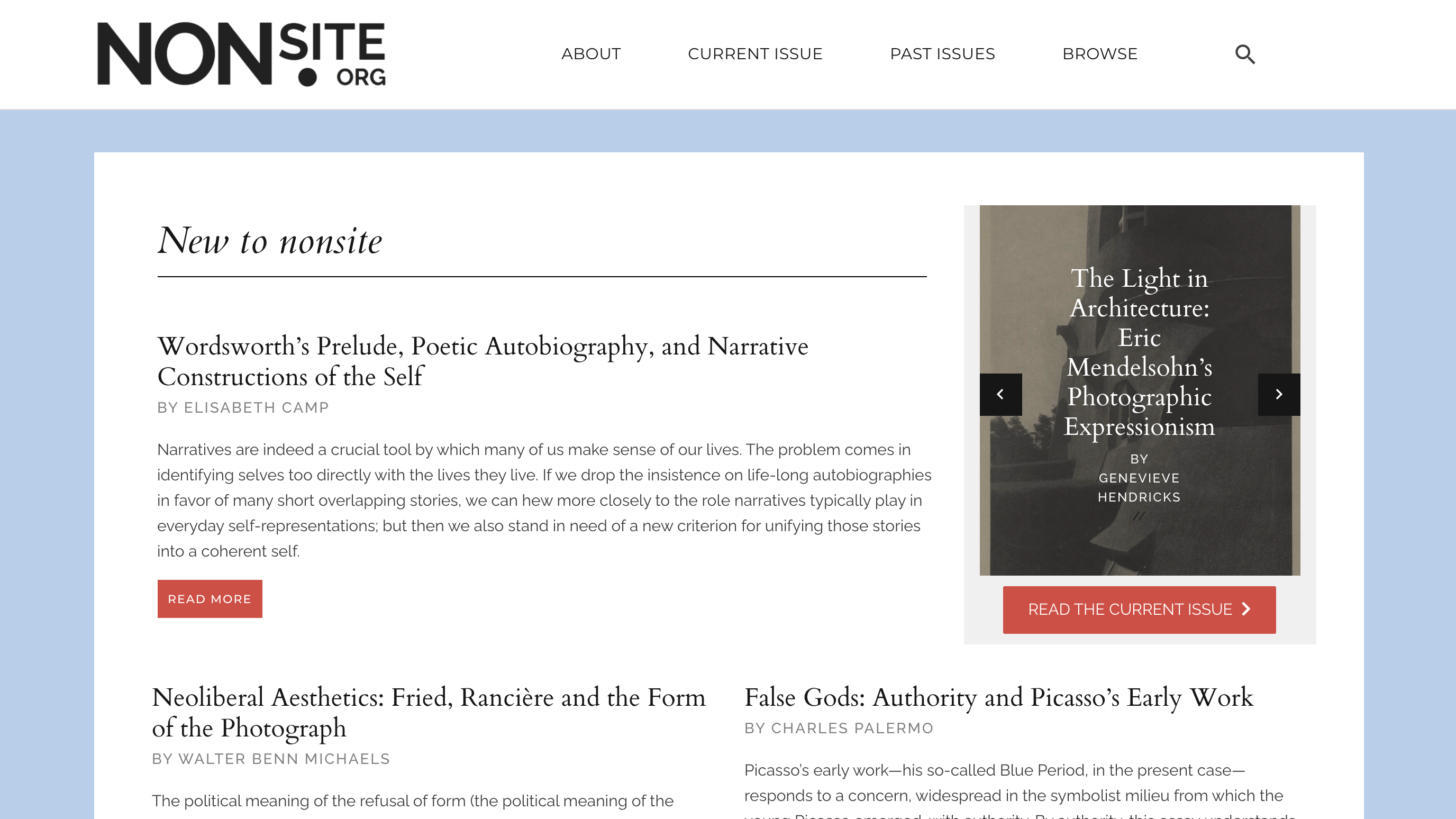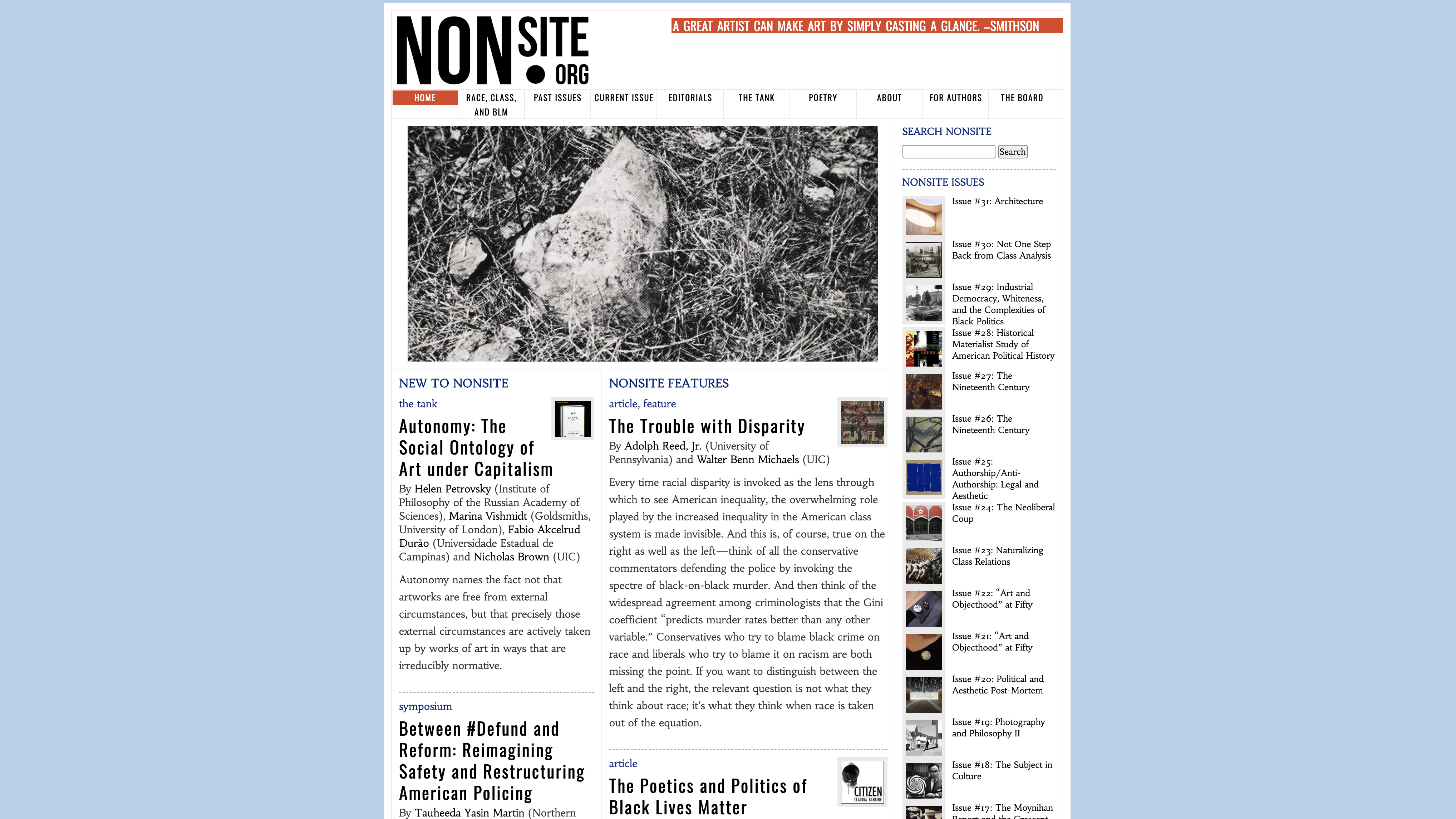The Emory Center for Digital Scholarship (ECDS) recently launched a redesigned website for nonsite, an online open-access academic journal. nonsite first launched in 2011, during a time of unprecedented growth for open access journals, and was as such an early example of online open-access publishing. Almost ten years and two million hits later, the editorial board approached ECDS about redesigning the journal to adapt to modern advances and methods of online engagement (including the use of newer WordPress features) since the inception of nonsite. The overall goal was to make the site more useable both for readers and for the editorial team, while still emphasizing the journal’s long history and creating something that “feels like nonsite.” Along with the website redesign, ECDS Systems Lead Chase Lovellette upgraded the web server, ensuring the journal’s sustainability. This blog post includes details about the redesign, provided by Dr. Kayla Shipp (ECDS Digital Scholarship Specialist), as well as background context for the journal.
- Visit the redesigned nonsite: https://nonsite.org/
What is nonsite?
In 2011 nonsite.org emerged “in part out of interest in a set of theoretical topics—the ontology of the work of art, the question of intentionality, the ongoing appeal of different and sometimes competing materialisms—and in part out of opposition to the dominant accounts of those topics.” The journal’s editorial identity rests in large part on the variety of disciplines it represents, as Dr. Todd Cronan (Associate Professor of Art History at Emory University and editor-in-chief of nonsite) explained in a 2012 lecture, and how those various disciplines are tackling a shared set of problems: “The editorial board is comprised of experts from a wide variety of fields, including artists, art historians, political scientists, historians of science, philosophers, musicologists, and literary critics. […] Our editorial identity is shaped by the desire to create a forum for conflict, debate, and discussion about the major issues in the humanities.” Over the years the journal’s emphasis has changed to a degree, largely in light of the crucial addition of Adolph Reed, Jr. to the board. Cronan explains that Reed has been a galvanizing force for recent issues and articles around the topic of race and class. Reed’s own writings have generated immense amounts of interest and brought a whole new audience to the journal. Further additions to the board have brought a new emphasis to the visual arts including two specialists in nineteenth century art and one in contemporary art.
The original WordPress site—everything from plugins to layout columns—had to be custom-built and maintained. Dr. Brian Kane (Associate Professor of Music at Yale University and a founding editor of nonsite) helped build and manage the website, creating custom plugins and setting nonsite up for success.
Organization/User Experience (UX)
nonsite publishes a mixture of articles; some articles that are associated with specific issues are published together, but others are published singly in between issues. Shipp explains that the nonsite board wanted a flexible layout for the front page that emphasized a selected group of articles (some taken from issues and others originally published on their own), while leaving space available for the latest full issue. Shipp also set out to address the issue of “orphan” articles, published outside of regular issues, becoming difficult to find once they were no longer on the homepage. She explains that the editorial board “wanted readers to know about and be able to access nonsite’s nearly ten years of published articles, but the original design only really worked for readers who already knew what they were looking for.”
Shipp and the board addressed these problems through both the underlying structure of the site and its layout: “At the top of the home page, I created a featured slider for the current issue’s articles and images, surrounded by excerpts of the individual articles newest to the journal. This set the issue content apart from the single articles, but made both equally easy to find. I also created a slider for a number of past issues at the bottom, as the editorial board felt that the access to past issues was an important means of communicating nonsite’s publication history.”
Each post and issue now have a “related reading” section generated through extensive subject tags added by Jaime Gonzalez (summer graduate assistant editor) and newly streamlined categories, plus a sidebar with options to browse all nonsite content by topic tag, section, or issue. Brian Kane shared his extensive knowledge of the original site to update and integrate plugins that enabled the publication of co-authored articles and the use of footnotes. Shipp also created pages that show all past issues, added pages that organize the content by topic tag, section, or author, and optimized the site’s search engine results. As a result, readers can take a variety of paths through the site’s content, making all past articles widely available.
Look and feel/User Interface (UI)
One of the key features of nonsite’s content is its use of editor-generated summaries of every article listed on the home and issue pages. The journal had previously used a small serif font for the excerpts and article content, which was potentially inaccessible for some readers. Shipp therefore updated the body font to a modern sans-serif font that was more readable in the small print of the excerpts and the body of the articles. She also remade the site’s logo in this font, to achieve a cohesive design aesthetic.
Shipp helped bring the site up to modern standards and practices in several ways. The redesign optimizes the entire site layout for mobile use by reducing the number of columns, while still keeping the blue border and accent color to maintain the same “feel” as the original site. Apart from the overall reorganization, behind-the-scenes functionality updates, and font changes, the largest single update to the site was in its use of images. Being an art journal, nonsite has a variety of images associated with nearly every post, but the old design only showed small, postage-stamp-style versions of each picture. Through the use of sliders and browse pages, Shipp re-emphasized the many significant images associated with each article and issue, allowing the site to more fully achieve its commitment to digital publishing methods, which include multimedia. As Cronan noted in the aforementioned 2012 lecture—titled “Beyond JSTOR: nonsite.org as Digital Publisher”—the “digital format affords specific capabilities and freedoms not available to print media.” Thanks to the help of Shipp and ECDS, the redesigned nonsite can now more fully embrace these advantages.
There is complete consensus among the board that the site redesign is a tremendous success. Cronan shares that “Shipp and ECDS have transformed the collective experience of the site: it is faster, more readable, and the functionality of the site has been vastly increased. We’re grateful that the hundreds of articles that we have published over the past ten years have been made newly accessible in a way that I think every author will appreciate. Undoubtedly the site redesign will attract new readers and authors to the site and allow our editorial vision to be broadcast in the most compelling way possible.”
More about open access publishing: Emory University will be celebrating International Open Access Week 2020 from October 19-25, 2020. Further details forthcoming!



